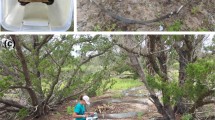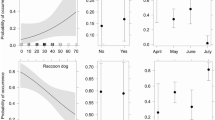Abstract
In colonial seabirds, nesting density, egg-laying date and nest microhabitat affect the probability of eggs being taken by avian predators. Jungle Crows (Corvus macrorhynchos) are dominant predators of eggs of Black-tailed Gulls (Larus crassirostris). Factors affecting the probability of gulls allowing the crows to attack their nests or depredate their eggs and the probability of eggs being taken were studied by direct observation and egg census, respectively. The effect of vegetation heights, position in the colony, egg-laying date and neighbour nests on the probability of eggs being taken were examined at multiple spatial scales. Gull nests were depredated more easily by larger groups of crows. Nests in peripheral areas (<4 m from the edge of the colony) were also depredated more easily by the crows walking on the ground. Although the nests where eggs were laid early in the season were depredated more frequently, such nests highly synchronised in egg laying within a <2-m radius were less likely to be depredated than less-synchronised nests. The nests in tall vegetation were less likely to be depredated though those having neighbour nests in tall vegetation were not. The number of neighbour nests did not affect the probability of eggs being taken. Antipredation effects of nesting microhabitats vary with spatial scales at which the crows search and attack the nests of gulls.

Similar content being viewed by others
References
Bosch M, Sol D (1998) Habitat selection and breeding success in Yellow-legged Gulls. Ibis 140:415–421
Buckley FG, Buckley PA (1980) Habitat selection and marine birds. In: Burger J, Olla BL, Winn HE (eds) Behavior of marine animals, Vol. 4. Plenum, New York, pp 69–112
Burger J, Gochfeld M (1981) Colony and habitat selection of six Kelp Gull Larus dominicanus colonies in South Africa. Ibis 123:298–310
Caro T (2005) Antipredator defences in birds and mammals. The University of Chicago Press, Chicago
Coulson JC (1968) Differences in the quality of birds nesting in the center and on the edges of a colony. Nature 217:478–479
Gaston AJ, Elliot RD (1996) Predation by ravens Corvus corax on Brunnich’s Guillemot Uria lomvia eggs and chicks and its possible impact on breeding site selection. Ibis 138:742–798
Gilchrist HG, Gaston AJ (1997) Effects of murre nest-site characteristics and wind conditions on predation by glaucous gulls. Can J Zool 75:518–524
Ims RA (1990) The ecology and evolution of reproductive synchrony. Trends Evol Ecol 4:135–140
Kim SY, Monaghan P (2005) Effects of vegetation on nest microclimate and breeding performance of lesser black-backed gulls (Larus fuscus). J Ornithol 146:176–183
Kosugi K, Sugimura N, Sato M (2005) Breeding colony status of Black-tailed Gull in Rishiri Island, northern Hokkaido (1) Estimated population from 2002–2004 (in Japanese with English abstract). Rishiri Kenkyu 24:29–35
Krebs JR, Davies NB (1997) Behavioural ecology: an evolutionary approach. Blackwell, Malden
Lack D (1954) The natural regulation of animal numbers. Clarendon, Oxford
Massaro M, Chardine JW, Jones IL (2001) Relationship between Black-legged Kittiwake nest-site characteristics and susceptibility to predation by large gulls. Condor 103:793–801
Montevecchi WA (1978) Nest-site selection and its survival value among Laughing Gulls. Behav Ecol Sociobiol 4:143–161
Montevecchi WA (1979) Predator–prey interactions between Ravens and Kittiwakes. Z Tierpsychol 49:136–141
Murphy EC, Schauer JH (1996) Synchrony in egg-laying and reproductive success of neighboring common murres, Uria aalge. Behav Ecol Sociobiol 39:245–258
Parrish JK (1995) Influence of group size and habitat type on reproductive success in Common Murre (Uria aalge). Auk 112:390–401
Pierotti R (1982) Habitat selection and its effect on reproductive output in the Herring Gull in Newfoundland. Ecology 63:854–864
Ricklefs RE (1969) An analysis of nesting mortality in birds. Smithsonian Contrib Zool 9:1–48
Schreiber EA, Burger J (2002) Biology of marine birds. CRC, Florida
Shealer DA, Burger J (1992) Differential responses of tropical Roseate Terns to aerial intruders throughout the nesting cycle. Condor 94:712–719
Shedd DH (1982) Seasonal variation and function of mobbing and related antipredator behaviors of the American Robin (Turdus migratorius). Auk 99:342–346
Siegel-Causey D, Hunt GL Jr (1981) Colonial defense behavior in Double-crested and Pelagic Cormorants. Auk 522–531
Tarvin KA, Garvin MC (2002) Habitat and nesting success ob Blue Jays (Cyanocittia Cristata): importance of scale. Auk 971–983
Tinbergen N, Impekoven M, Franck D (1967) An experiment on spacing-out as a defense against predation. Behaviour 28:307–321
Watanuki Y (1983) Predation and antipredation behavior in seabirds on Teuri Island, Hokkaido. J Yamashina Inst Ornithol 15:167–174
Wittenberger JF, Hunt GL Jr (1985) The adaptive significance of coloniality in birds. In: Farner DS, King JR, Parkes KC (eds) Avian biology Vol. 8. Academic, New York, pp 1–78
Acknowledgment
Thanks to Y. Sakurai and Y. Watanuki for helpful comments during the course of the study. Thanks are also due to N. Takahashi, H. Sahara, J. Kaji and K. Asamidori for support in the field. Marine Biomedical Institute of Sapporo Medical University provided space and resources to work in the field. Thanks to A. Takahashi and anonymous reviewers for many valuable comments.
Author information
Authors and Affiliations
Corresponding author
About this article
Cite this article
Kazama, K. Factors affecting egg predation in Black-tailed Gulls. Ecol Res 22, 613–618 (2007). https://doi.org/10.1007/s11284-006-0064-2
Received:
Accepted:
Published:
Issue Date:
DOI: https://doi.org/10.1007/s11284-006-0064-2




